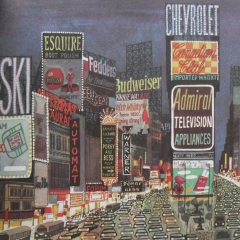Cities are what makes our world run the way it does. They are incubators for new thoughts, ideologies, innovations, etc. In a simple analogy, if the world is a car, cities are its running engine. And cities have been in the center of attention when it comes to thoughts of the future. This kind of speculations picked up momentum after the industrial revolution when the bulk of the human population shifted from rural to urban areas, and an exponential urban growth started to take place which accentuated the role of the city. In the middle of the 20th century, futurists imagined cities with all sorts of exotic fantasies: floating cars, humongous skyscrapers as big as mountains, flying body suits, etc. Few expected that none of those fantasies would translate to reality.
Now the time has come to reflect upon those questions again. What will the cities of the future hold to us? Will they be as exciting as modern futurists have theorized? Is hypothesizing the future even relevant? Hasn’t technology proved again and again that innovation is a potent yet erratic process? What are the challenges that we might encounter? We shall examine those questions in the following article.
ghhjkl
What is a city, really? In a very pragmatic description, it’s an agglomeration of human-built structures that form a matrix, with a spatial hierarchy that try to fit their needs in accordance to their history, culture and location. Cities, as living organisms, go through extensive evolution, altering their morphology throughout time. They are in a forever changing situation, seeking an unreachable state of balance. Every generation that passes contributes to this process by adding, removing or repurposing parts of it. These changes can be as orchestrated as completely arbitrary. In this context comes the role of urbanistic architecture, armed by a set of rules and regulations, it attempts to tame these dynamics through order. In doing so, it reaffirms some of the state authority over the individual initiative to keep a coherent space.
The modernistic approach to urbanism tried to categorize every part of the city by applying a zoning policy at the beginning of the 20th century and, by giving every district in the city a unique function, – business, residential, leisure – many times failed to achieve the desired goals. Those policies often created hostile, deserted urban spaces and social segregation frequently emerged as a byproduct. Understanding why this so-called perfect system collapsed could be traced to several factors but one simple idea stands out: urban planners dealt with the city as a mechanical process omitting the human factor, by laying down strict policies that in theory work but in practice, they failed to take into consideration the individual.
These planners wished to create the Perfect City, where everyone can enjoy the luxuries of the modern lifestyle with all its perks and none of its disadvantages. Citizens would live in modernistic towers, work in the business district and get some entertainment in the recreational areas, all easily accessible by cars. The modern city planning revolved around the car as a primary transportation method. What a dream! Very progressive for their time certainly, though a naïve approach since it can’t be replicated everywhere to all scenarios in the exact same fashion. Ironically, the architecture style at that time was referred to as the “international” style. This style rejected the architectural project’s context as a design restriction and rather adopted a unified “international” approach which resulted in a series of stripped-down buildings replicated all over the world with total disregard for their surroundings.
As an example, Le Corbusier, an iconic architect of that period, created a new plan for Paris named the “Plan Voisin”¹, which advocated for the total demolition of the historical center of Paris and its rebuilding entirely based on uniform skyscrapers surrounded by a big urban park. This approach summarizes the modern ideology to urbanism. The controversial plan failed to pass legislation and was rejected.
Modernist thought of creating a futuristic city through the reorganization of its layout, on what was then a completely different approach to architecture. It was a rebellious act, a big statement in the history of architecture, which mirrors the ideology of their time when it comes to the vision of the future.
In my opinion, the contemporary approach to city planning will have to shift from a strictly architectural point of view to a more practical technological one. In other words, urbanism must adopt the rapid advancement we are witnessing in our era and apply it to city development. The cities of the future will assimilate these technologies in several manners ranging from how to lay down policies to more practical everyday problems as we are going to discuss.
As we enter the era of data, we are generating an unfathomable amount of information that makes data collection an easier process than it used to be. In the past, sociologists had to rely on a representative, yet very small, number of people to base their data collection from and subsequently extrapolate their observations. Nowadays, as a lot of tech companies have proved, data collection is happening on such a large scale that you can use it to generate models and predictions to forecast or influence the near future. This tool, used in the proper manner, can help city planners when it comes to laying down policies and optimizing the city layout by relying on accurate data and not just mere observations or rough statistics. This analysis is already taking place in niche segments such as traffic management, but it still isn’t a widespread tool. As the data collection mechanism expands every year and more technologies will use it and benefit from it, a positive feedback loop will take place, where the more technologies we adopt, more data will be generated. A new approach to the city will therefore be established forever. Naturally, regulations must encompass this process to protect the individual privacy and regulate which data must be collected or discarded.
Another big shift that we are witnessing is the rapid development in automation. How will automation affect city, you may ask? Well, if you imagine a city where self-driving cars are as reliable as a human operated one, the whole transportation industry will witness a paradigm shift. Firstly, new parking will free up space by relocating itself outside the city center since your car can simply drive you to work and go park somewhere else. New opportunities will unveil as we discover car-free streets and sidewalks. Secondly, as this technology improves², we can imagine that your car could be used as a public transport service like Uber. When you don’t need it, it could go and be used as a taxi by other city residents. This system could be upscaled to result in a publicly operated service, where the municipality supplies a fleet of vehicles that can be rented for short periods and facilitate the shift towards less reliance on personal vehicles, thereby relieving congestion by reducing the total amount of cars inside the city.
The future of cities is infinite, and in this article, I have mentioned just some example of how the city can evolve practically in its new urban technological paradigm. The city is still however a very complex organism and our most successful approaches to tailor it to our needs so far is through trial and error. After each urban design iteration, we perform an experiment that stretches decades or even centuries. It is a slow process but the more we learn, the more mature we become in dealing with its complexity. A city can be analyzed, dissected and studied in many ways by an array of disciplines but for architects, it reflects principles, hopes and wishes. And as society matures, so do our cities. To dream of futuristic cities, what we must do in the first place is to develop our principles and values as a society and then maybe, one day, decades or even centuries from now we shall achieve our “city of the future”.
¹ Plan Voisin, Paris, France, 1925, Fondation Le Corbusier, www.fondationlecorbusier.fr, date of consultation 27/09/2019.
² Tom Huddleston Jr., Elon Musk says self-driving tech could mean consumers will have a limited time to buy Teslas at current prices, www.cncb.com, last modified 08/07/2019, date of consultation 25/09/2019.
– Panerai, Castex, Depaule, Formes urbaines de l’îlot à la barre, France, Editions Parenthèses, 1997.
– Jeanneret-Gris C.E., Vers une Architecture, France, Lars Muller, 1923.










